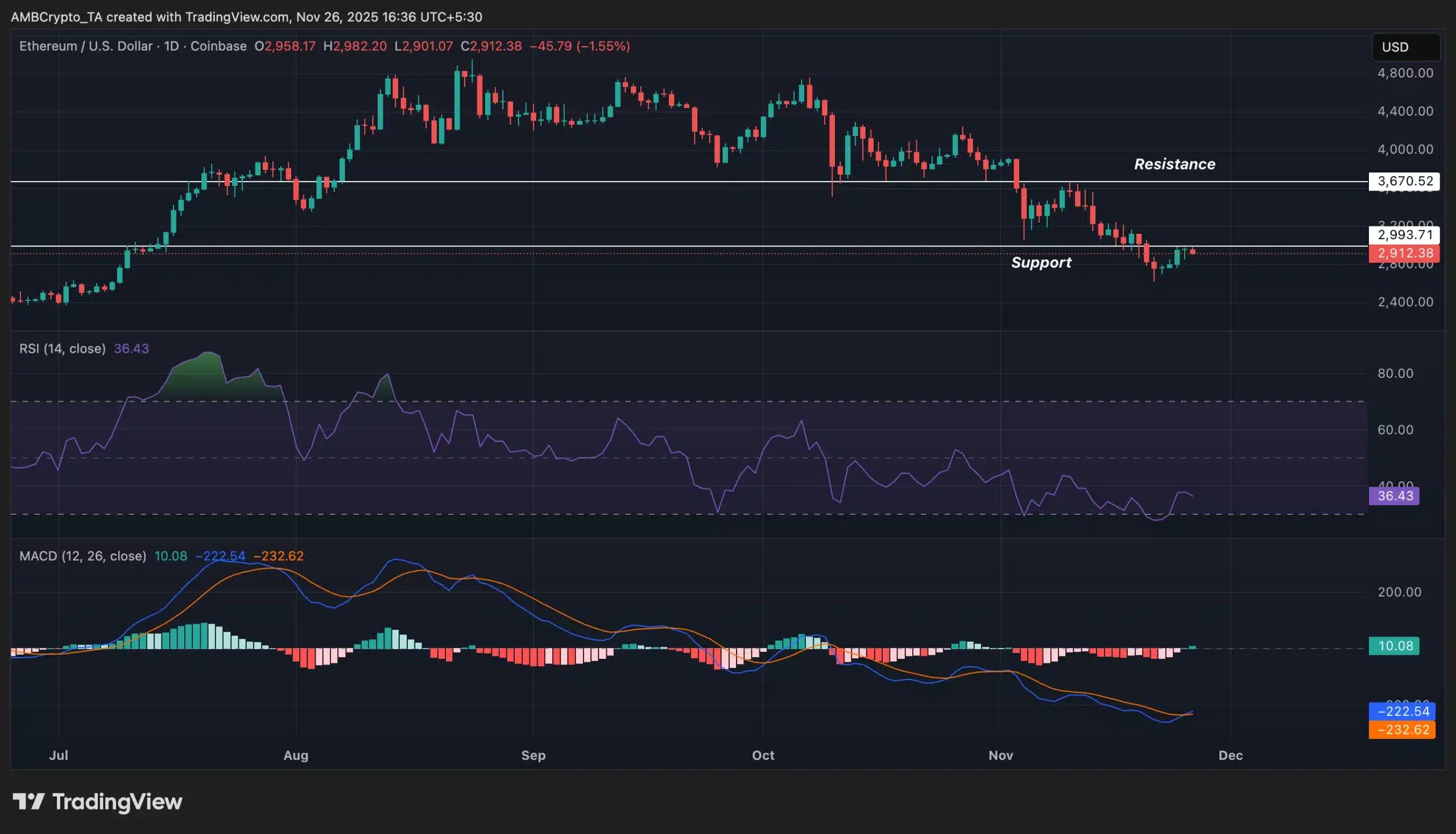Ethereum Spot ETFs recorded $96.6 million in inflows on November 24, 2025, led by BlackRock’s $92.6 million contribution, followed by $78.6 million on November 25, signaling renewed investor interest despite price pressures.
-
Ethereum ETFs saw strong inflows, with BlackRock and Fidelity leading the charge amid market volatility.
-
Technical indicators like RSI and MACD show short-term bearish signals, but these may not indicate long-term weakness.
-
Ethereum’s price hovered around $2,913, down over 30% in a month, influenced by broader macro factors including U.S. economic uncertainties.
Discover the latest Ethereum ETF inflows: $96.6M on Nov 24 and $78.6M on Nov 25. Explore price trends, technical analysis, and Binance ETF news. Stay informed on crypto investments today.
What are the latest Ethereum ETF inflows?
Ethereum ETF inflows have shown resilience recently, with net inflows reaching $96.6 million on November 24, 2025, primarily driven by BlackRock’s Ethereum Trust. This marked a significant uptick after a period of stagnation, highlighting growing institutional confidence in Ethereum despite broader market challenges. The following day, inflows continued at $78.6 million, underscoring sustained interest in the asset.
How have specific Ethereum ETFs performed in recent inflows?
Ethereum Spot ETFs experienced varied performances across issuers. On November 24, BlackRock’s ETHA ETF captured $92.6 million, its first inflow in two weeks, while other funds saw minimal activity. By November 25, Fidelity’s FETH led with $47.5 million, closely followed by BlackRock’s $46.2 million and Grayscale’s $8.3 million addition. However, Grayscale’s ETHE faced $23.3 million in outflows, as reported by Farside Investors data. These figures reflect selective investor preferences amid Ethereum’s price struggles. Short paragraphs like this aid readability, allowing quick scans of key data points. Overall, the inflows total over $175 million in two days, a positive signal for Ethereum’s ecosystem.
At a time when the market buzzes with discussions on new altcoin ETF launches, Ethereum’s steady yet powerful momentum in ETF performance is often underappreciated. The world’s largest altcoin ETF – the Ethereum Spot ETF – has been building strength since its debut earlier in 2025, coinciding with the historic Bitcoin ETF rollout. Latest numbers indicate that investor confidence in Ethereum remains robust, even as the asset navigates volatility.
Ethereum ETF inflows analysis
On November 24, 2025, Ethereum Spot ETFs logged a robust $96.6 million in net inflows, with BlackRock accounting for the bulk at $92.6 million, ending a two-week dry spell for the fund. This surge points to renewed appetite among institutional players for Ethereum exposure through regulated vehicles.
The positive trend persisted into November 25, with ETH ETFs drawing an additional $78.6 million. Fidelity’s FETH ETF spearheaded the day with $47.5 million, while BlackRock’s ETHA followed closely at $46.2 million. Grayscale’s ETH also contributed $8.3 million, though its flagship ETHE product saw continued outflows of $23.3 million, per data from Farside Investors.
Despite these encouraging inflows, Ethereum itself grapples with a challenging price landscape, which underscores the disconnect between on-chain interest and spot market dynamics.
ETH price action
During the period of these ETF inflows, Ethereum traded around $2,913.41, struggling to breach the $3,000 resistance after a more than 30% decline over the past month, according to CoinMarketCap metrics. This downturn contrasts sharply with the asset’s performance at the Ethereum ETF launch on July 23, 2025, when it closed at $3,418.61.
Ethereum’s current price weakness is not isolated but mirrors broader cryptocurrency market pressures. Factors such as potential U.S. government shutdown risks, evolving expectations for Federal Reserve rate cuts, and a general risk-off sentiment in global financial markets have weighed heavily on digital assets.
Technical indicators further illustrate this short-term turbulence. The RSI and MACD currently suggest a bearish phase, but analysts caution that such signals might represent temporary fluctuations rather than fundamental deterioration in Ethereum’s outlook.


Source: Trading View
Interestingly, this bout of weakness has drawn major Ethereum whales back into the fray. Following a nearly 9% rebound from the recent low of $2,623, large holders reactivated, snapping a month-long downtrend in whale activity. On-chain analytics revealed dormant wallets transferring substantial ETH volumes, suggesting accumulation at lower price levels.
Such movements align with historical patterns where whales capitalize on dips, potentially stabilizing Ethereum’s price in the medium term. Data from platforms like Santiment highlight increased whale transactions, a bullish on-chain indicator amid ETF gains.
Binance ETF developments
While Ethereum contends with its volatility, the ETF landscape expands further. VanEck has submitted a filing for a Spot Binance Coin ETF, known as VBNB, to be listed on Nasdaq. The proposed fund would directly hold BNB tokens, mirroring the price of the MarketVector BNB Index.
Staking capabilities are absent at launch, but VanEck indicated that future implementations could involve third-party custodians with advance regulatory notification. This filing arrives as BNB trades at $857.52, up 0.57% in the last 24 hours yet down over 25% monthly, echoing the macro headwinds impacting Ethereum and the wider crypto sector.
The Binance ETF proposal builds on the success of Bitcoin and Ethereum ETFs, potentially broadening institutional access to top altcoins. Regulatory scrutiny remains key, as the SEC evaluates risks associated with BNB’s ecosystem, including its ties to the Binance exchange. Experts from firms like Bloomberg Intelligence note that approval could accelerate altcoin adoption, though timelines extend into 2026.
In the context of Ethereum’s inflows, this development signals a maturing ETF market for cryptocurrencies, where Ethereum continues to lead as the premier altcoin vehicle. Institutional inflows into ETH ETFs demonstrate Ethereum’s foundational role in blockchain innovation, from DeFi to layer-2 scaling solutions.
Frequently Asked Questions
What caused the recent Ethereum ETF inflows surge?
The surge in Ethereum ETF inflows, totaling over $175 million from November 24-25, 2025, stems from institutional bargain-hunting amid price dips. BlackRock and Fidelity’s strong contributions reflect confidence in Ethereum’s long-term utility, despite short-term macro pressures like U.S. fiscal uncertainties.
Is Ethereum’s price expected to recover soon?
Ethereum’s price, currently around $2,913, faces near-term headwinds from bearish RSI and MACD signals, but whale accumulation and ETF inflows suggest potential stabilization. Recovery depends on broader market sentiment and Federal Reserve decisions, with historical rebounds often following such dips.
Key Takeaways
- Ethereum ETF Inflows Strength: Recent $96.6 million and $78.6 million inflows highlight institutional resilience, led by BlackRock and Fidelity, countering price volatility.
- Technical Bearish Signals: RSI and MACD indicate short-term weakness, but these may prove transient, with on-chain whale activity pointing to accumulation opportunities.
- Broader ETF Momentum: VanEck’s Binance ETF filing expands the altcoin landscape, potentially benefiting Ethereum’s ecosystem through increased market legitimacy and capital flows.
Conclusion
In summary, Ethereum ETF inflows demonstrate enduring appeal for the asset, with significant capital entering despite price challenges around $2,913 and bearish technicals. As the Binance ETF filing underscores expanding opportunities, Ethereum’s role in crypto innovation remains pivotal. Investors should monitor regulatory updates and macro trends for future positioning, staying engaged with evolving market dynamics.
